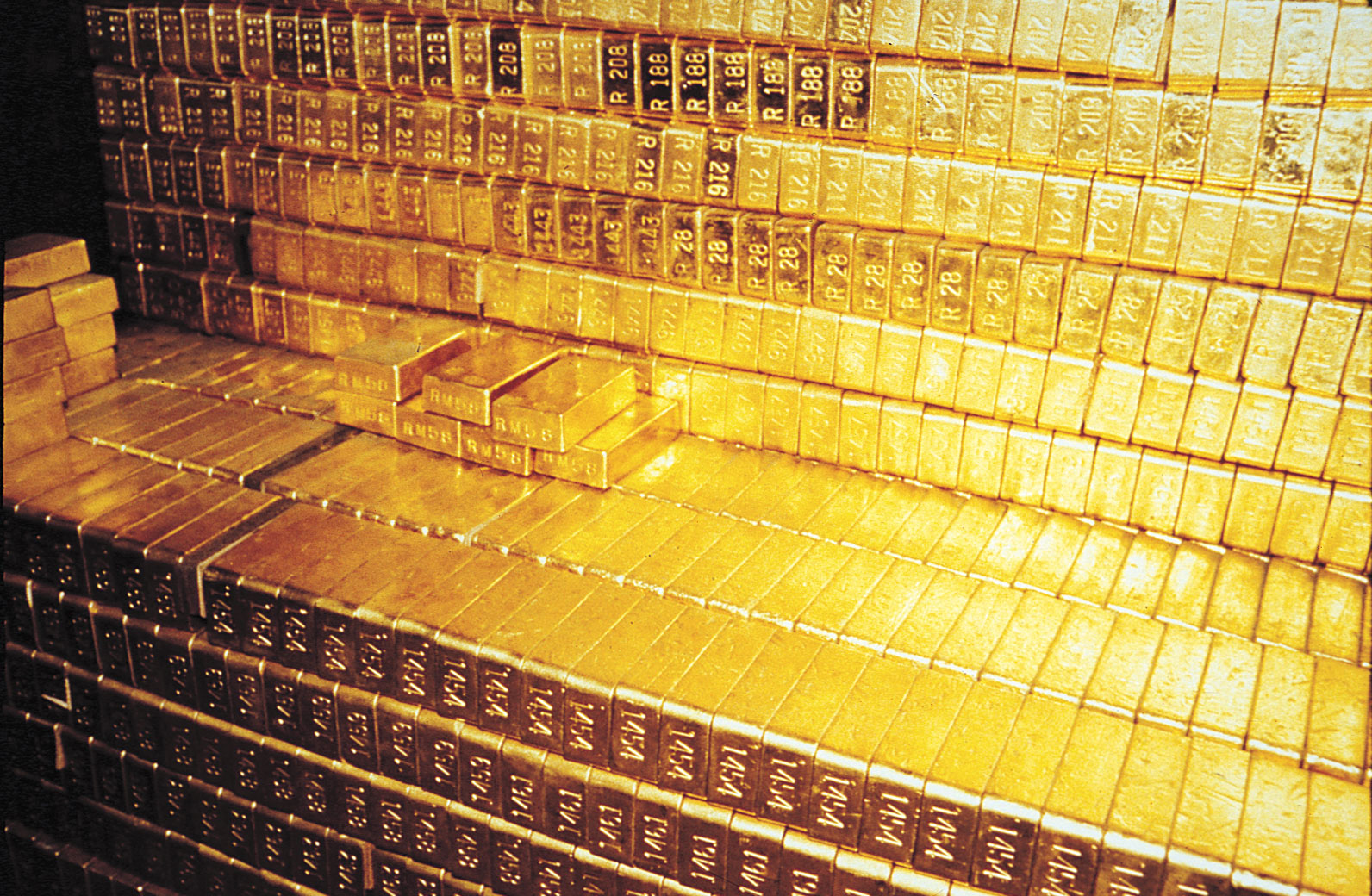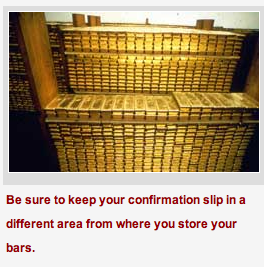Gold & Precious Metals
Gold’s Paradigm Shift in investor attitudes since April
Posted by Ben Traynor - Bullion Vault
on Tuesday, 18 June 2013 20:44
 Gold drifted to a one-week low below $1,380 an ounce Tuesday morning, as silver dipped below $21.80 an ounce, with stocks and commodities broadly flat on the day ahead of tomorrow’s U.S. Federal Reserve decision, with analysts speculating on whether the Fed will give details of when and how it might slow down its quantitative easing program.
Gold drifted to a one-week low below $1,380 an ounce Tuesday morning, as silver dipped below $21.80 an ounce, with stocks and commodities broadly flat on the day ahead of tomorrow’s U.S. Federal Reserve decision, with analysts speculating on whether the Fed will give details of when and how it might slow down its quantitative easing program.
“The outlook for the gold price remains negative from a technical perspective,” says Karen Jones, head of FICC technical analysis at Commerzbank.
“Following the mid-April plunge, the market has consolidated tightly sideways in a converging range. We are viewing this as a potential symmetrical triangle. A close below $1,352 will complete the pattern and trigger another leg lower we suspect.”
“We believe that the dramatic gold sell-off in April,” adds a note from Societe Generale, “combined with the prospect of the Fed starting to taper its QE program before year-end, has resulted in a paradigm shift in many investors’ attitude toward gold. This is likely to result in continued large-scale gold ETF selling this year and next.”
The SPDR Gold Trust (ticker: GLD), the world’s largest gold exchange traded fund (ETF), has seen outflows this year amounting to a quarter of the gold it held to back its shares at the start of January.
In Washington, the Federal Open Market Committee begins its latest two-day monetary policy meeting today, with a decision due tomorrow.
“[There is] much speculation as to whether [the FOMC] will detail an exit strategy [from QE],” says a note from Dutch bank ING.
“While there are views that the Fed will want to see bond yields lower, or certainly highlight that policy rates will not be raised for a significant period, we see merit in the view that transparency is the best policy choice – and it is time to more formally outline the normalization process.”
ING also argues that Fed policy uncertainty “has seen soaring volatility destroy the carry trade”, whereby investors could borrow cheaply in dollars to invest in emerging market assets.
Fed Chairman Ben Bernanke meantime has stayed in his job “longer than he wanted” and has “done an outstanding job”, according to President Barack Obama, speaking in an interview broadcast Monday.
Over in the U.K., consumer price inflation rose to 2.7% last month, up from 2.4% a month earlier, figures published Tuesday show. Mervyn King steps down as Bank of England governor at the end of this month. For the 120 months of his tenure, inflation has been above the Bank’s target in 84 of them.
Over in India, the world’s biggest gold buying nation, the authorities “are not at the end of our wits as far as gold imports are concerned,” Economic Affairs Secretary Arvind Mayaram said Monday. “If required, there are other measures that can be taken and they will be considered at the appropriate time.”
India has raised import duties on gold twice this year — taking them to 8% — and has also restricted imports of gold on a credit basis to only those who will re-export it. Gold and silver was India’s second biggest import item last year and has been cited as a major contributor to the country’s current account deficit.
Over in China, the world’s largest stock market-listed jewelry chain Chow Tai Fook today reported a 13% drop in profits for the year to March, a filing with Hong Kong’s stock exchange shows. The company cited “declining confidence of domestic consumers” as a factor behind the fall in profits.
Sales of silver bullion American Eagle coins by the US Mint meantime are set to record their best first-half-of-a year since at least 1986 — the year from which U.S. Mint sales data start — with more than 24 million ounces sold so far this year.
CME Group’s new 1,000 ounce silver futures contract saw 25 lots of the September contract traded in its first day of trading yesterday, with five lots of the December contract traded. By comparison, volume for the standard 5,000 contract was 11,028.
About the Author
Ben Traynor
Editor of Gold News, the analysis and investment research site from world-leading gold ownership service BullionVault, Ben Traynor was formerly editor of the Fleet Street Letter, the UK’s longest-running investment letter. A Cambridge economics graduate, he is a professional writer and editor with a specialist interest in monetary economics.

- I’m getting a lot of emails to do more macro analysis of the gold market, and the time is ripe to do so.
- “We need to continue to push for long-term capital inflows and therefore the FDI policy has to undergo a revamp…. We need to move in this direction quickly and it needs to be a paradigm shift in how we look at FDI.” – Arvind Mayaram, Economic Affairs Secretary of India, June 17, 2013, Bloomberg News.
- FDI refers to “foreign direct investment in India”. The Indian government charges an 8% duty on gold that is imported into the country. There is also a 4% sales tax.
- In the short term, the Indian government is applying a lot of pressure to its gold-loving citizens, but they are also working quickly to dramatically increase foreign investment in the country. I’m 99% sure that once FDI increases, exports will boom, the rupee will stabilize, and the government will reduce the import duties on gold.
- Also, Indian gold dealers have tremendous experience handling situations like this. They are already working feverishly with partners in Dubai. Indian gold dealers are not shrinking their operations. They are expanding them, both at home, and abroad.
- “An 8 per cent duty on gold import plus 4 per cent sales tax on gold purchases has made huge price difference between India and the UAE. There is 12 per cent difference in the cost of buying gold from the UAE and India. Hence more and more Indian jewellers will be setting up shop here. We are already positioned in this market, but others are likely to follow suit,” – Sham Lal, Managing Director, Malabar Gold and Diamond, Emirates 24/7 News, June 18, 2013.
- More than 20% of the world’s gold already flows through Dubai. Volume is increasing, and Indian gold dealers are expanding their operations there.
- Even Societe General (SOGEN), the most bearish of the Western bullion banks, believes that demand for gold jewellery will increase strongly.
- April 12, 2013 was the beginning of a two day “super-crash” in the gold market. In my professional opinion, the gold bull market ended on that day.
- The world changed on April 12, 2013, because the Western gold bull market ended, and the Asian gold bull era began. With all due respect to the Western gold community, it’s probably time to face the music. On April 12, 2013, the sun began to set on the relevance of the West to the POYG (price of your gold).
- I’m personally planning to boycott the FOMC minutes release on Wednesday. I invite others in the Western gold community to join me. If nobody in Chindia (China & India) cares about Ben Bernanke’s relevance to the POYG, should you care? I don’t think so, and I mean that purely from a wealth-building standpoint.
- Fundamental events in the West, like speeches from Ben Bernanke, will continue to move the POYG, to a degree. Traders can attempt to capitalize on those moves, but intermediate and long term investors should focus on the Asian gold bull era. In the gold market, Asian citizens have certainly “got your back”.
- Chinese paper gold markets are beginning to take shape nicely, and the fund managers expect capital inflows to increase on price drops. The decline of the Western paper gold markets is probably a good thing, because when gold falls in price, those weak markets see capital outflows.
- Asian paper markets will be vastly superior entities, and I expect them to quickly overwhelm Western paper gold markets, in both size and power.
- India is likely to soon see a new boom in exports, as the US economy continues to strengthen modestly. Every day, more Indians come off the farms into the cities. Every person in India wants to buy gold regularly. It’s just a question of whether they can afford to buy it. In the big picture, Indian gold demand is driven not by economic booms or busts. It’s driven by the ongoing exodus from the farms to the cities, and that has barely started.
- As the standard of living increases in India, gold demand will increase accordingly. A decline in the gold price will trigger more buying, but a rise in price will still see Indians buy huge amounts of gold.
- The Indian government doesn’t want to see a dramatically lower gold price, because that would cause a huge surge of buying by Indian citizens, putting greater pressure on the current account deficit. The bullion banks need to be careful in how they handle the current situation. Both the Chinese and Indian central banks could threaten to overwhelm comex selling with their buying, if there are further “attacks” on the gold price there.
- If you believe that the world changed, on April 12, 2013, a relatively minor $100 price drop is not something to be afraid of.
- The West owns very little gold now, so the ability of Western investors to drive the price a lot lower, is highly questionable. Also, the power of Asian media is something that the gold bears may be underestimating. My main sources of news are mostly Asian, and websites like “China Daily”, are beginning to get a following in the West.
- China Daily’s site is growing fast. It reputedly has 500 million users. There’s also a US edition. Asian media is generally pro-gold, while Western media seems to feature a lot of “gold-haters”. People like Nouriel Roubini are arguably making themselves look ridiculous and ant-sized, with their angry gold-bashing.
- I hope this update puts a shimmer on your gold, and takes you away from a lot of the unwarranted negativity that surrounds the mightiest metal.
- Let’s take a look at the charts now, and see if they support my macro analysis. Please click here now . That’s the daily gold chart, and you can see that my stokeillator is on a light sell signal. Gold has broken down from a tiny triangle, likely because Western traders are betting that the Fed makes a statement that is negative for gold. I don’t see anything on that chart that gold investors need to be overly-concerned about.
- Please click here now . Double-click to enlarge. That’s the monthly chart for gold. Note the “buy box” between $1266 – $1155. The two blue arrows highlight the congestion pattern that created this key HSR (horizontal support & resistance) zone. SOGEN’s technical analysts predict that gold will fall to $1200. I predict that I’ll buy it there, and so should the Western gold community, if it happens. I’m not so sure that much lower prices will happen. Note the action of the 4,8,9 series MACD green histograms. They’ve started to turn up, which is bullish.
- Please click here now . Double-click to enlarge. That’s the GDX daily chart. A lot of technicians believe there is a head & shoulders bottom in play, but it may be just a shape, rather than an actual chart pattern. Regardless, there is definitely serious resistance where these technicians have drawn the neckline, which is in the $30.50 – $31.27 area. Asia will need your miners to get them more gold than they are currently mining, in the coming years. Technically, GDX could fall to $22 as easily as it could rise to $35. In the longer term, the gold bull era probably began on April 12, 2013. Asians don’t hate mining stocks. Give them time to prove it!
Jun 18, 2013
Stewart Thomson
Graceland Updates
website: www.gracelandupdates.com
email for questions: stewart@gracelandupdates.com
email to request the free reports: freereports@gracelandupdates.com
About Stewart Thomson”
Stewat is a retired Merrill Lynch broker. Stewart writes the Graceland Updates daily between 4am-7am. They are sent out around 8am. The newsletter is attractively priced and the format is a unique numbered point form; giving clarity to each point and saving valuable reading time.

Part II: The Wrong and Right Way to Buy Gold
Posted by Martin D. Weiss, Ph.D & Larry Edelson
on Monday, 17 June 2013 17:53
Nearly 21 months ago, one of the world’s leading analysts and proponents of gold shocked the investment community with the announcement that the yellow metal was headed south.
Most of his colleagues in the industry scoffed. But his loyal followers took action according to his explicit instructions: They bought gold hedges for protection against the decline. They liquidated their mining shares. And then they waited — sometimes patiently, sometimes anxiously — for his next major “buy” signal.
That gold analyst is Weiss Research’s Larry Edelson, and last week, I began this three-part series of fascinating interviews with him. Here’s Part II …
Martin Weiss: Larry, for the sake of those who missed Part I of this interview, please lay out the full dimensions of the opportunity.
Larry Edelson: My analysis tells me the next leg of the gold bull market will not end for three full years. It will not peak until the yellow metal is at $5,000 per ounce or more. And it will spin off a long series of trading opportunities in virtually every investment that’s tied to gold and other precious metals — bullion, shares, ETFs, plus unique trades that most investors are unfamiliar with.
Martin: Starting immediately?
Larry: Too soon to say, but we are getting very close to it, yes.
But I must repeat: Do not jump in prematurely or all the way as so many gold investors have continually done in the past 21 months or so. And certainly not with all of your money.
Martin: OK. Meanwhile, last week, you gave us very practical guidance on the wrong and right ways to buy bullion coins. Can you expand on that now?
Larry: Sure. In addition to the coins I talked about last week, there’s also a variety of gold coins available in much smaller sizes, enabling you to buy gold in relatively small increments of less than 1 ounce. The drawback has always been price: The smaller the coin, the greater the premium.
Thus, as you buy smaller and smaller denominations, you get progressively less and less gold for your money, because the premium is higher. However, some folks in the industry who favor these smaller-denomination coins set forth two counter arguments:
First, they say the premium can be recovered when you resell the coins.
Martin: Is that true?
Larry: Half true, and not always. On average, right now, you’ll probably lose half and recover half.
Look. We’re talking about “fractional coins.” And the market for the full ounce gold coins is far broader, deeper and more liquid than for these fractional gold coins. When you go to sell three years from now, you may even have to accept an additional discount with the smaller coins rather than recover part of the premium lost on the purchase.
The second argument they make is that in an economic catastrophe, the smaller gold coins would be easier to spend or swap for groceries, gas, etc.
Martin: True or not?
Larry: Perhaps. But it’s also possible that in an economic catastrophe, the full ounce coins — because of their wider distribution — would be equally easy (or easier) to spend. But who can know for sure?
Martin: Can we switch from small things to big things? If you’re a large investor and you want to invest in gold bullion in substantial amounts, where do you go?
Larry: Let’s talk about 1,000-ounce bars. Even at the best-priced dealers, you can expect to pay anywhere from 30¢ to about $1 an ounce over spot when you buy them from a good delivery brand, like Engelhard or Johnson Matthey.
However, if you’re prepared to invest substantial sums at one time, you can save almost that entire fee. You can buy gold at just pennies more than the actual spot price: Buying a “spot month” gold futures contract from your regular commodities broker and take delivery of it.
 Martin: Can you give us an example?
Martin: Can you give us an example?
Larry: The contract will be for 100 ounces of gold and the commissions run between $40 and $100 — which works out to less than $1 an ounce.
The problem is that 100 ounces of gold can cost more than most investors want to lay out at one time. For instance, at $1,400 gold, to take delivery of one futures contract would involve $140,000 (100 ounces times $1,400 an ounce). It also involves buying and taking delivery of a futures contract. Not something I recommend except for the largest of investors.
A better alternative may be to buy directly from a wholesaler. Just be aware of some of the restrictions.
First, most wholesalers require minimum purchases of the precious metals.
Second, most are not set up to service small retail accounts. They are not going to give you advice, nor will they try to help you make a decision or give any other brokerage-type services. If you have a question about what to buy, how much, when and so forth, don’t go to them.
Third, most require payment in advance, before they can even lock in a price. The advance can be sent in the form of a bank wire, cashier’s check or a certified check.
Note that ingots and bars are available in sizes ranging from as small as 1 gram of gold to 10- and 100-ounce bars. Naturally, the smaller the ingot or bar, the higher the premium you’ll usually pay.
Martin: What about the kilo gold bar?
Larry: It’s the unit of choice in almost all international gold transactions. But there are pros and cons.
First, the positive side. Each of the bars carries a serial number. Have your dealer record the serial number and hallmark on your confirmation slip. Don’t keep it where you store the bar. If the bar is stolen, you are in a much better position to deal with the insurance company by having a readily identifiable number to cite, as opposed to reporting that “X” number of unidentifiable coins were stolen.
Also, you’re in a much better position to claim your property should the police ever recover it. So the serial number is a desirable feature of buying kilo bars.
On the negative side, they’re a relatively unattractive way to hold gold. There’s nothing beautiful about a kilo bar, compared with the artistic engravings available by buying coins. In addition, bars aren’t divisible.
Martin: Larry, I have a lot more to ask you, especially when it comes to security and storage. Plus, I want to ask you about other platforms and vehicles that can open up this tremendous opportunity to average investors who don’t want to have to worry about all the pitfalls, premium intricacies, paperwork, legal protections and whatnot. Can we do that next week?
Larry: Absolutely! See you then.
About Martin D. Weiss, PH.D.
Martin D. Weiss is one of the nation’s leading providers of a wide range of investment information. He is chairman of The Weiss Group, Inc. which consists of four separate corporations, including Weiss Research, Inc., the publisher of the Safe Money. This investment news is brought to you by Money and Markets. Money and Markets is a free daily investment newsletter from Martin D. Weiss and Weiss Research analysts offering the latest investing news and financial insights for the stock market, including tips and advice on investing in gold, energy and oil. Dr. Weiss is a leader in the fields of investing, interest rates, financial safety and economic forecasting. To view archives or subscribe, visit http://www.moneyandmarkets.com.

Wall Street Betting Against Silver Price.
THE U.S. DOLLAR gold price drifted back below $1390 an ounce Monday morning in London, but remained well within its trading range of the last few weeks, as European stock markets edged higher, with analysts citing Wednesday’s Federal Open Market Committee decision on US monetary policy as “the big driver” for this week.
“On the whole, the market hopes for insightful comments in the course of the next Fed policy meeting…which will affect gold’s further development as well,” says a note from bullion refiner Heraeus.
Any so-called ‘tapering’ of the Fed’s $85-billion-a-month quantitative easing program “would be bearish for gold and the other precious metals” says Jonathan Butler, precious metals strategist at Mitsubishi in London.
On the New York Comex, the so-called speculative net long position in gold futures and options – calculated as the number of ‘bullish’ long minus ‘bearish’ short contracts held by traders classed as speculators – fell in the week ended last Tuesday, according to Friday’s weekly Commitment of Traders report from the Commodity Futures Trading Commission.
Silver meantime edged back below $22 an ounce, as other industrial commodities were broadly flat on the day, while on the currency markets the Euro held steady against the Dollar above $1.33.
For silver futures, the number of short contracts held by those in the Managed Money category – which includes hedge funds and other money managers – was slightly larger than the number of long contracts, CFTC data show. The last weekly reports to show money managers betting on aggregate against the silver price were published in April – prior to that no managed money net short silver position had been published since September 2007.
“Silver has been trying in vain to regain the $22 per troy ounce mark…[but] the high level of pessimism among money managers is putting pressure on the price,” says today’s commodities report from Commerzbank.
The world’s biggest gold exchange traded fund SPDR Gold Trust (ticker: GLD) saw the volume of bullion held to back its shares hold steady at 1003.5 tonnes Friday, though it ended last week down 3.6 tonnes. The GLD has seen outflows amounting to one quarter of the gold it held at the start of this year.
Despite this, the GLD’s biggest holder, hedge fund Paulson & Co., says it has no intention of closing its Gold Fund, news agency Bloomberg reports, citing a letter to investors it has obtained.
“While gold continues to pivot between negative investment appetite, which has slowed, and softer physical demand, this week the market focus will shift to the FOMC meeting and press conference,” a note from Barclays says.
“The markets are a little bit fatigued at the moment,” agrees Victor Thianpiriya, commodities analyst at ANZ.
“They are still looking for direction from the Fed meeting. That’s clearly the big driver this week.”
Over in China meantime, Huaan Asset management, one of two physically-backed gold ETF providers to be approved by the China Securities Regulatory Commission, has said it aims to attract $400 million of initial funding – equivalent to around 9 tonnes at current prices – though no launch date has yet been announced.
“Gold hasn’t lost its appeal as a store of value in China,” says fund manager Xu Yiyi, who will run the Huaan ETF.
“Investors here usually like to buy on dips, so a decline in the bullion prices this year should work in our favor.”
Over in India, the only country with stronger gold demand than China last year, gold and silver imports amounted to $8.4 billion last month, a 90% year-on-year rise, though this was down from April’s 138% annual rise, a trade ministry official said Monday. India’s trade deficit meantime widened from $17.8 billion in April to $20.1 billion last month.
Gold and silver prices fell sharply in April, prompting a spike in physical gold demand, while Indian importers were also reported last month to be looking to get ahead of new regulations. Earlier this month, Indian authorities raised the import duty on gold to 8%, the second hike this year, and also curbed imports on a consignment basis.
In Northern Ireland meantime the conflict in Syria and tax avoidance are expected to be two of the major topics discussed by world leaders meeting for the G8 summit.
In Iran, outgoing president Mahmoud Ahmadinejad has been summoned to appear before a criminal court, the Washington Post reports, following the election Sunday of his successor Hasan Rohwani, a reputed moderate who won 51% of the vote.
Ben Traynor
Editor of Gold News, the analysis and investment research site from world-leading gold ownership service BullionVault, Ben Traynor was formerly editor of the Fleet Street Letter, the UK’s longest-running investment letter. A Cambridge economics graduate, he is a professional writer and editor with a specialist interest in monetary economics. Ben can be found on Google+
(c) BullionVault 2013
Please Note: This article is to inform your thinking, not lead it. Only you can decide the best place for your money, and any decision you make will put your money at risk. Information or data included here may have already been overtaken by events – and must be verified elsewhere – should you choose to act on it.

Smart Comments on this Week’s Crucial Fed Meeting
Posted by Various Commentors
on Monday, 17 June 2013 12:52
 The language Bernanke uses in his post-meeting press conference will be interesting.
The language Bernanke uses in his post-meeting press conference will be interesting.
George Goncalves, interest rate strategist at Nomura, thinks Bernanke will use this opportunity to clarify some communication hiccups that the Fed has been having:
Thus the key event this week is the June FOMC meeting. If they strike the right tone, in our opinion, that should help keep the bullish price-action intact. We believe a Bernanke led FOMC will take this opportunity to make a clear distinction between tapering QE programs versus its commitment to keep Fed Funds rate “lower for longer”. A combination of Bernanke‟s Q&A, an updated SEP forecast (where fed hike expectations can shift to out years) and a clear statement that codifies policy differences while flagging concerns over inflation would set the record straight.
Jon Hilsenrath of the WSJ: The key thing to watch is the Fed’s forecast of the path of the economy.
At the conclusion of its two-day policy meeting on Wednesday, the Fed will release its updated projections of growth, inflation and unemployment.
The evolution of these forecasts is a critical issue. Fed officials are unlikely at this meeting to change their $85-billion-per-month bond-buying program—launched to boost growth by pushing down long-term interest rates and pushing up asset prices, and spurring spending, hiring and investment.
But what they say about the economy will send important signals about what they expect to do in the future. If they maintain confidence in their economic forecasts, it could signal they think they’re on track to begin pulling back the program later this year.
Mike O’Rourke of JonesTrading explains why Hilsenrath is likely spot-on in his assessment:
We think this article is extremely important and provides a clear path to the correct interpretation of the FOMC’s view. The key takeaway will be to focus on whether the Fed maintains the forecast released in the March Summary of Economic Projections (SEP) when the June SEP is released. The reason that we have a high degree of confidence in the Hilsenrath article is that nearly identical sentiments were expressed by another important Fed watcher, Greg Ip of The Economist in a CNBC interview. Many will remember that Ip was Hilsenrath’s predecessor as the Fed watcher at the WSJ.


-
I know Mike is a very solid investor and respect his opinions very much. So if he says pay attention to this or that - I will.
~ Dale G.
-
I've started managing my own investments so view Michael's site as a one-stop shop from which to get information and perspectives.
~ Dave E.
-
Michael offers easy reading, honest, common sense information that anyone can use in a practical manner.
~ der_al.
-
A sane voice in a scrambled investment world.
~ Ed R.
Inside Edge Pro Contributors

Greg Weldon

Josef Schachter

Tyler Bollhorn

Ryan Irvine

Paul Beattie

Martin Straith

Patrick Ceresna

Mark Leibovit

James Thorne

Victor Adair

